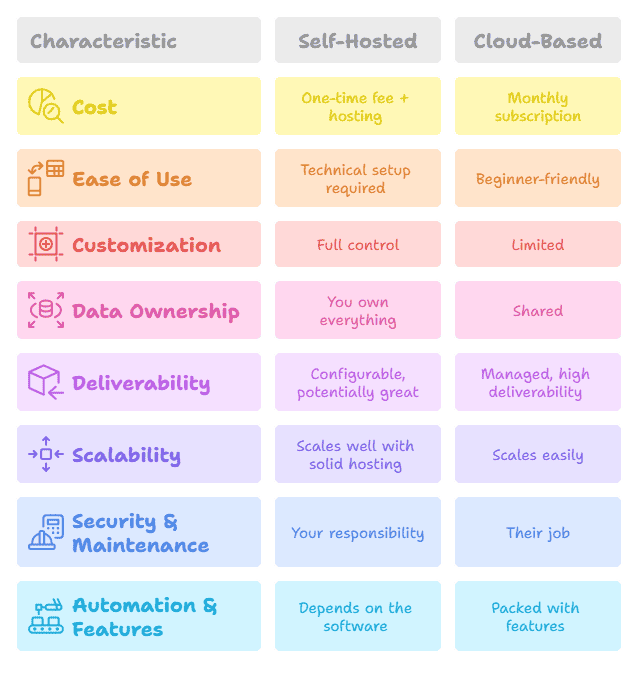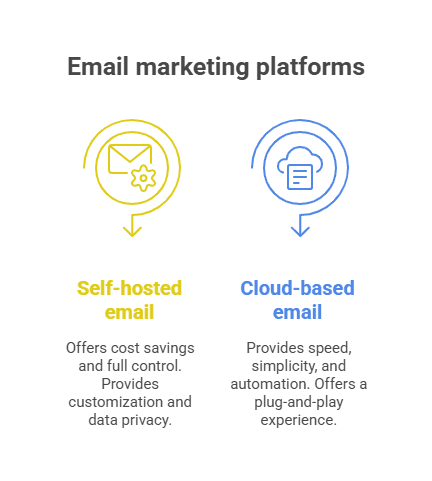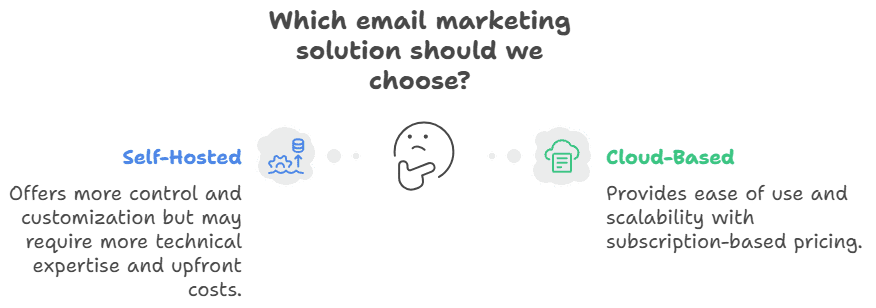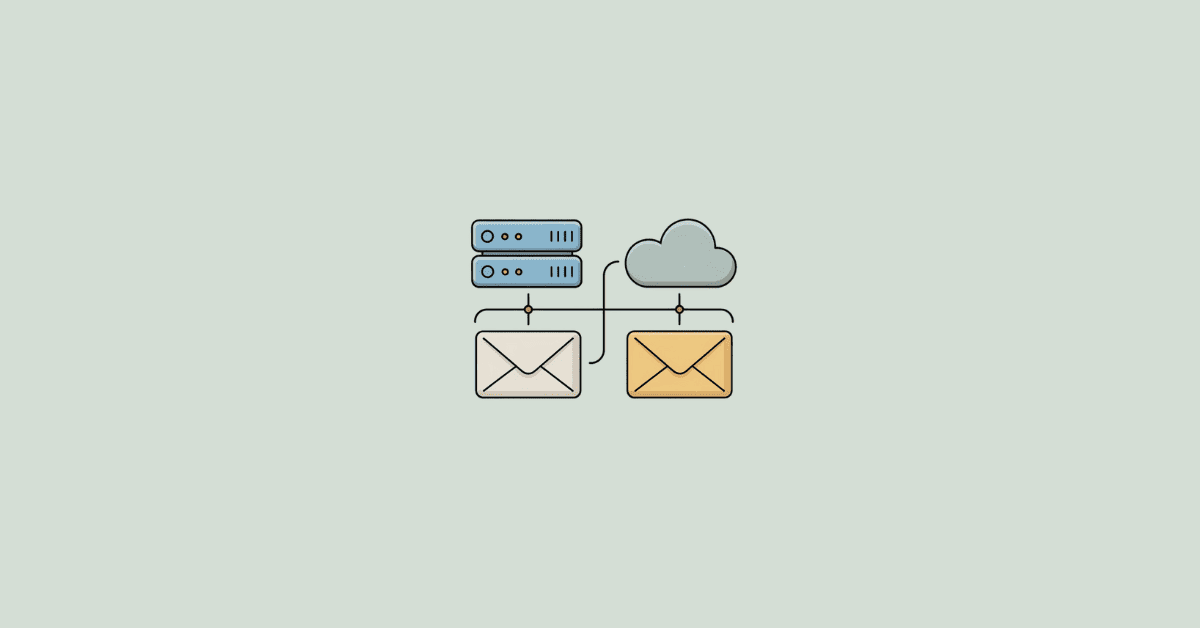You’ve been growing your email list for a few months now. Subscribers are rolling in, open rates look good, and you’re starting to feel like a proper digital marketer. Then—bam! You get hit with that monthly email bill. It’s creeping up faster than your growing email list. And suddenly, you start wondering. “Is there a better way to do this?”
You’re not alone.
This is the point where many creators, business owners, and email marketing enthusiasts start hearing whispers about self-hosted email marketing tools. No recurring bills? Full control? Sounds too good to be true. Right?
On the other hand, some people swear by cloud-based email marketing platforms like Mailerlite, Sender, or Kit. Easy to set up, packed with automation, and no server headaches.
So, now you’re stuck between two solid options:
- Which makes sense between Self-hosted vs. cloud-based email marketing?
- Which of these email platforms fits your needs and won’t cost you a kidney later?
- And most importantly, which gives you more freedom without sacrificing deliverability?
If any of those questions sound familiar, you’re in the right place for an answer.
In this post, we’ll look into the pros and cons of self-hosted and cloud-based email marketing, and help you find which email marketing setup is best for your business.
Whether you’re a beginner with a small email list or already managing 50K+ subscribers, this comparison will save you money, time, and stress.
Table of Contents
What is Self-Hosted Email Marketing?
Alright, let’s look at it this way.
Self-hosted email marketing means you own and run the email marketing software yourself, usually on your own server or web hosting. Instead of logging into a third-party email marketing platform, like Mailerlite or Kit, you’re managing the tool from your hosted dashboard, and you control your campaign without being at the mercy of a third-party company.
Think of it like cooking at home instead of ordering takeout. You buy the ingredients (hosting, domain, email software), set up the kitchen (install and configure the tool), and then you can make anything you want, on your own terms.
So, how does it work?
You install email marketing software like Mautic, Relayzo, Mailster, FluentCRM (for WordPress users), or Mailwizz. These tools give you full control over your campaigns, list management, automation, and analytics, without relying on third-party providers to do the heavy lifting.
Then, you connect that software to an email delivery service like Amazon SES, Mailgun, or your own SMTP. These services are responsible for actually sending the emails out to your subscribers. And yes, most of them are cheaper than what typical cloud platforms charge per email.
So, what makes self-hosted email tools worth considering?
- You pay once (or pay a small server/SES fee), instead of monthly.
- You own your subscriber data; it’s not sitting on someone else’s server.
- You can customise the platform however you want (especially if you’re a bit tech-savvy).
But there’s a tradeoff; self-hosted email marketing software is not plug-and-play. You’ll either need to roll up your sleeves or hire someone to help you set it up, maintain it, and keep things secure.
Still, marketers who want freedom and scalability without getting robbed every billing cycle need to consider self-hosted email marketing software. It is a serious power move and a smart marketing decision.
What is Cloud-Based Email Marketing?
Now, if self-hosted email is like cooking in your own kitchen, cloud-based email marketing is like eating at your favourite restaurant, everything’s already set up, the service is smooth, and someone else handles the cleanup.
With cloud-based platforms, you don’t have to worry about servers, security patches, or SMTP configurations. You just sign up, log in, and start building and sending email campaigns. Everything from your contact list to your analytics sits neatly inside their system, hosted on their servers.
You’ve probably heard of the popular names: HubSpot, Kit, MailerLite, Sender, and Moosend. These are all cloud-based email marketing tools. They’re built for speed, simplicity, and scale. No software installation. No server headaches. Just log in and start sending.
So, what makes cloud-based email marketing tools the go-to choice for so many?
- Ease of use: No setup stress. Drag, drop, send.
- Built-in templates: Beautiful, mobile-friendly designs ready to use.
- Automation tools: Advanced sequences, segmenting, and tags—without needing a tech team.
- Deliverability handled: You don’t have to worry about IP warming or blacklists, they handle all that behind the scenes.
Most cloud-based email marketing platforms offer free trials or “freemium” tiers, too, which makes them ideal for beginners or anyone testing the waters. As your list grows, you can usually scale up your plan with a few clicks.
But of course, all this convenience comes at a price.
You’re renting the platform, so monthly fees keep climbing as your list grows. Some tools also limit how much control you have over your data, and you might get hit with restrictions or account bans if their system flags your campaign as “suspicious.” Even if you’re playing by the rules.
Self-Hosted vs. Cloud-Based Email Marketing: Pros and Cons
Let’s be honest, no tool is perfect. What works like a charm for you might drive someone else crazy. That’s why this self-hosted vs. cloud-based email marketing comparison will give you a better picture and help you decide.
Here’s the comparison table:

So, what’s the takeaway?
If you’re on a tight budget or want full control of your email list, self-hosted email marketing is better for your business.
But if you want to get started fast, focus on content, and let someone else deal with the tech mess, then cloud-based email marketing platforms are the way to go.
There’s no “one-size-fits-all” here, just what fits you right now, and what you’re willing to handle behind the scenes.
What to Consider Before Choosing an Email Marketing Setup
Choosing between self-hosted and cloud-based email marketing isn’t just about features or cost. It’s about fit.
Like buying shoes, you can’t just go by looks. If they don’t fit your feet (or your budget, skill level, and business goals), they’ll cause more pain than progress.

Here’s what to think about before you make your move:
- Your Budget
If your monthly email bill is starting to look like a housing repayment plan, you might need to switch over.
Self-hosted email marketing platforms like MailWizz, Relayzo or Swift Send are one-time payment software, aside from hosting and email-sending costs (like Amazon SES or Mailgun). Long-term? Way cheaper. But upfront? You may need to pay a developer or spend hours to set them up.
Meanwhile…
Cloud-based email platforms are subscription-based. Super convenient, but your bill grows as your email list grows. Some tools charge per subscriber, even if they’re inactive.
It’s now dependent on whether you want to invest more time to save money, or would you rather pay more to save time.
- Your Technical Skills
To be honest, self-hosted email marketing isn’t for you if you’re tech-phobic. You’ll need to: install software, set up cron jobs, verify domains (SPF, DKIM, DMARC) and keep things updated and secure.
If that sounds a bit scary, you can follow the documentation and installation process of any self-hosted email software you want to install or hire someone like me to do it for you.
On the flip side, cloud platforms let you skip all that. They’re beginner-friendly, drag-and-drop, and built for people who want to get stuff done.
- Your Growth Plans
Are you just starting with a small list? Or are you aiming to hit 50K+ subscribers in a year?
Cloud-based email tools are easy to scale but can drain your profit margin as your email list grows.
Self-hosted email marketing tools scale well, too, but you’ll need solid hosting and occasional maintenance to keep things running smoothly.
If you’re planning to grow fast and need maximum flexibility, owning your infrastructure might make more sense in the long term.
- Automation and Integration Needs
If automation and workflows are a big part of your strategy, like abandoned cart emails, lead nurturing sequences, or webinar reminders, pay close attention here.
Most cloud-based email marketing tools come with pre-built automation and third-party integrations (Shopify, WordPress, CRMs, payment platforms, etc.).
Most self-hosted email marketing platforms also support automation and integrate with other tools like WordPress, but setting them up requires technical knowledge.
- Data Ownership and Privacy
This one’s a biggie, especially for agencies, medical professionals, or anyone handling sensitive subscriber data.
With self-hosted email software, you own everything. You control your list, backups, and how data is handled.
With cloud-based email marketing tools, you’re handing over that control to someone else. They could suspend your account for a policy violation, or worse, lose your data during a system failure.
If data control is a priority for your brand or industry, self-hosted wins hands down.
- How Much You Send (and How Often)
If you send massive newsletters weekly or you’re running high-volume transactional emails daily, cost per email matters.
Self-hosted + Amazon SES has low sending costs (we’re talking cents for thousands of emails).
For cloud-based email marketing, the more emails you send, the more you pay.
My professional Verdict?
If you want cost savings and full control, consider Self-hosted email marketing software like Relayzo, Mautic, Swift Send or phpList. If you need speed and simplicity, consider a Cloud-based email marketing platform, such as Mailerlite, Sender, HubSpot, and Kit.
If you want customisation + data privacy, consider one-time payment self-hosted email marketing software, like MailWizz, Maildoll, Acelle, Swift Send, and Relayzo. If you want to enjoy the Plug-and-play experience, consider Cloud-based email marketing like Moosend, Sender, Kit, and MailerLite.
Which Email Marketing Platform is Best?
You’ve seen the features, the costs, pros and cons, but maybe you’re still wondering, “Yeah, but which one is best for someone like me?”

Here’s what you need to know to choose the better email marketing platform.
Choose Self-Hosted Email Marketing If You…
- Know your way around tech (or hire someone to do it for you)
- Want to own everything, your list, your platform, your data
- Hate paying monthly bills for something you could manage in-house
- Send high volumes of emails regularly and want to cut costs long-term
- Need full control over how your emails look, behave, and are tracked
- Run an agency or business that values privacy, compliance, and flexibility
Popular tools to check out:
- Swift Send
- Acelle
- Maildoll
- XSender
- ListMonk
Choose Cloud-Based Email Marketing If You…
- Have zero interest in setting up servers or managing software
- Love user-friendly dashboards and automation templates
- Need pre-built integrations with tools like Shopify, Stripe, Calendly, WordPress, etc.
- Want to focus on content, sales, or engagement, not infrastructure
- Want customer support available when things break or get confusing
Popular tools to explore:
Final Thoughts
Choosing between self-hosted vs. cloud-based email marketing comes down to one simple question: Do you want more control or convenience?
If you’re tech-savvy (or willing to learn), self-hosted tools can save you a lot of money and give you total ownership of your email list. It’s a long-term investment that pays off, especially if you’re sending emails regularly or managing a large audience.
If you’re more interested in speed, simplicity, and support, cloud-based email marketing platforms could be a better option. They take care of the backend while your focus is on building relationships, selling your products, or growing your brand.
Both paths are legit. Both have helped thousands of businesses grow.
If you’re still unsure, you can start with a cloud-based email platform and as your list (and expenses) grow, you can switch to a self-hosted solution, or run both side by side.
If you have any questions, you can drop them in the comments.
Frequently Asked Questions (FAQs)
Here are some of the most common questions people ask when choosing between self-hosted and cloud-based email marketing platforms.
What is the difference between self-hosted and cloud-based email marketing?
Self-Hosted Email Marketing: This involves hosting your email marketing software and data on your own servers or infrastructure. You have full control over the software, customisation, and security.
Cloud-Based Email Marketing: This involves using a third-party service provider to host and manage your email marketing platform. The software is accessed via the Internet, and the provider handles maintenance, updates, and security.
Can I switch from a cloud-based email tool to a self-hosted platform later?
Yes, you can. You’ll need to export your email list (usually in CSV format), import it into your self-hosted tool, and set up your campaigns from scratch. It’s not automatic, but it’s doable, especially if you’re moving to save money or gain more control.
Which is more beginner-friendly: self-hosted or cloud-based?
Cloud-based platforms win this round. They’re built for ease—drag-and-drop editors, built-in templates, and zero setups. Self-hosted tools require more time and effort upfront, and usually a bit of tech knowledge.
What’s the cheapest way to send bulk emails?
Self-hosted + a service like Amazon SES is by far the cheapest combo. You only pay cents for thousands of emails. Great for newsletters, promos, or daily campaigns with a tight budget.





0 Comments